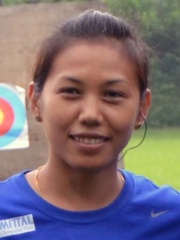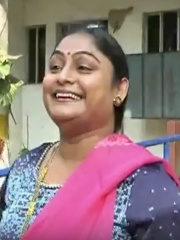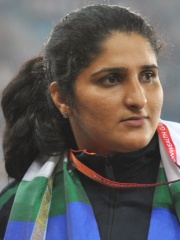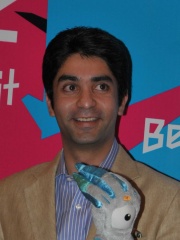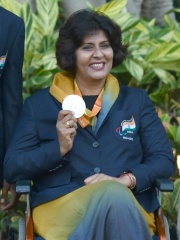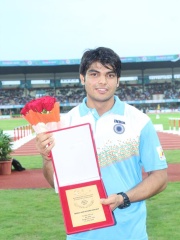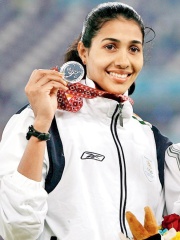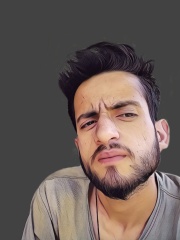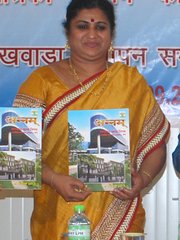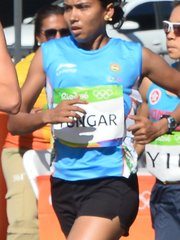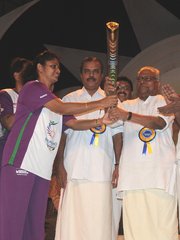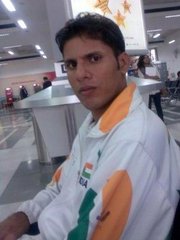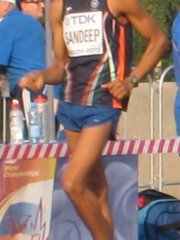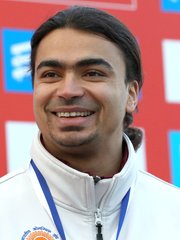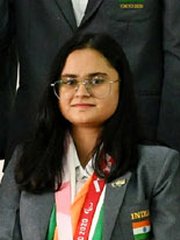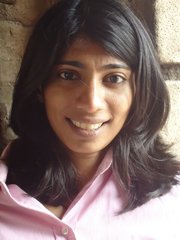
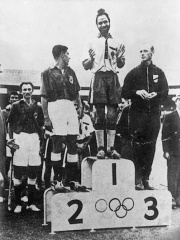
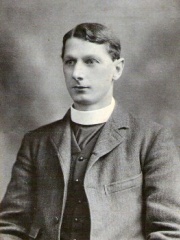

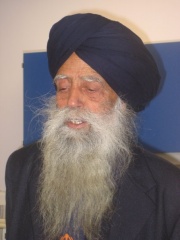
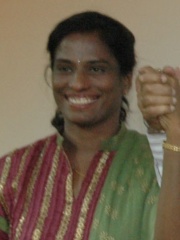

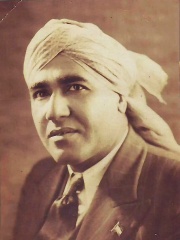
The Most Famous
ATHLETES from India
This page contains a list of the greatest Indian Athletes. The pantheon dataset contains 6,025 Athletes, 135 of which were born in India. This makes India the birth place of the 29th most number of Athletes behind Argentina, and South Africa.
Top 10
The following people are considered by Pantheon to be the top 10 most legendary Indian Athletes of all time. This list of famous Indian Athletes is sorted by HPI (Historical Popularity Index), a metric that aggregates information on a biography's online popularity. Visit the rankings page to view the entire list of Indian Athletes.

1. Godfrey Brown (1915 - 1995)
With an HPI of 63.84, Godfrey Brown is the most famous Indian Athlete. His biography has been translated into 22 different languages on wikipedia.
Arthur Godfrey Kilner Brown (21 February 1915 – 4 February 1995) was a British athlete, winner of a gold medal in the 4 × 400 m relay at the 1936 Summer Olympics. He later became Headmaster of the Royal Grammar School Worcester, a post which he held from 1950 until his retirement in 1978.

2. Balbir Singh Sr. (1923 - 2020)
With an HPI of 59.11, Balbir Singh Sr. is the 2nd most famous Indian Athlete. His biography has been translated into 21 different languages.
Balbir Singh Dosanjh (10 October 1924 – 25 May 2020) predominantly known as Balbir Singh Sr., he was a hockey player and was an Indian hockey player and coach. He was a three-time Olympic gold medalist, having played a key role in India's wins in London (1948), Helsinki (1952) (as vice captain), and Melbourne (1956) (as captain) Olympics. He is regarded as one of the greatest hockey players of all time, a modern-day Dhyan Chand, a legend of the sport, and is widely regarded as the sport's greatest ever centre-forward. His Olympic record for most goals scored by an individual in an Olympic men's hockey final remains unbeaten. Singh set this record when he scored five goals in India's 6–1 victory over the Netherlands in the men's field hockey final of the 1952 Olympic Games. He was often called Balbir Singh Senior to distinguish him from other Indian hockey players named Balbir Singh. Singh scored 246 goals from just 61 international caps and scored 23 goals in just 8 Olympic matches Singh was the manager and chief coach of the Indian team for the 1975 Men's Hockey World Cup, which India won, and the 1971 Men's Hockey World Cup, where India earned a bronze medal. During the London Olympics in 2012, Singh was honoured in the Olympic Museum exhibition, "The Olympic Journey: The Story of the Games,” held at the Royal Opera House. The exhibition told the story of the Olympic Games from its creation in 776BC through to the London 2012 Olympic Games. He was one of the 16 iconic Olympians recognized as an example "of human strength and endeavour, of passion, determination, hard work and achievement and demonstrates the values of the Olympic Movement". Singh died in Mohali Fortes Hospital on 25 May 2020 while in ICU due to suspected case of Pneumonia after he experienced high fever.

3. Charles Gmelin (1872 - 1950)
With an HPI of 59.04, Charles Gmelin is the 3rd most famous Indian Athlete. His biography has been translated into 26 different languages.
Charles Henry Stuart Gmelin (28 May 1872 – 12 October 1950) was a British athlete. He competed at the 1896 Summer Olympics in Athens.

4. Launceston Elliot (1874 - 1930)
With an HPI of 58.83, Launceston Elliot is the 4th most famous Indian Athlete. His biography has been translated into 26 different languages.
Launceston Elliot (9 June 1874 – 8 August 1930) was a British weightlifter, and the first athlete representing the United Kingdom to become an Olympic champion.

5. K. D. Jadhav (1926 - 1984)
With an HPI of 55.98, K. D. Jadhav is the 5th most famous Indian Athlete. His biography has been translated into 19 different languages.
Khashaba Dadasaheb Jadhav (15 January 1925 – 14 August 1984) was an Indian freestyle wrestler. He is best known for winning a bronze medal at the 1952 Summer Olympics in Helsinki. He was the first athlete from independent India to win an individual medal in the Olympics. After Norman Pritchard who won two silver medals in athletics in 1900 under colonial India, Khashaba was the first individual athlete from independent India to win a medal at the Olympics. In the years before Khashaba, India would only win gold medals in field hockey, a team sport. He is the only Indian Olympic medalist who never received a Padma Award. Khashaba was extremely nimble on his feet, which made him different from other wrestlers of his time. English coach Rees Gardner saw this trait in him and trained him prior to the 1948 Olympic games. He belonged to Goleshwar village near Karad. He was posthumously awarded Arjuna Award in 2000 for his contribution to wrestling.

6. Fauja Singh (1911 - 2025)
With an HPI of 55.91, Fauja Singh is the 6th most famous Indian Athlete. His biography has been translated into 20 different languages.
Fauja Singh (died 14 July 2025) was a British Indian marathon runner. At the time of his birth in Punjab province in British India, birth certificates were not typically issued, so his age could not be verified by third parties. Later in life, he became a marathon runner, participating in marathons all over the world. He beat a number of world records in multiple age brackets, but none of his times were ratified as records. His personal best time for the London Marathon (2003) was 6:02, and his marathon best, claimed for the 90-plus age bracket, was 5:40 at the claimed age of 92, at the 2003 Toronto Waterfront Marathon. He died in Punjab in 2025, in a hit and run incident.

7. P. T. Usha (b. 1964)
With an HPI of 53.09, P. T. Usha is the 7th most famous Indian Athlete. Her biography has been translated into 30 different languages.
Pilavullakandi Thekkeparambil Usha (born 27 June 1964) is an Indian sports administrator, parliamentarian and retired track and field athlete. She was born in Koothali near Perambra in Kozhikode district, Kerala, and grew up in Payyoli. Usha has been associated with Indian athletics since 1979. She has won a total of four gold and seven silver medals in the Asian Games. She is often associated as the "Queen of Indian track and field". In July 2022, she was nominated as a Member of Parliament to the Rajya Sabha, the upper house of the Indian Parliament. In December 2022, she was elected president of the Indian Olympic Association unopposed. That same month, she was appointed to the panel of Rajya Sabha vice-chairman to control the proceedings of the upper house during the absence of both Chairman and Deputy Chairman. Usha is the first nominated parliamentarian in history to become the vice-chairperson of the Rajya Sabha.

8. Leslie Claudius (1927 - 2012)
With an HPI of 50.26, Leslie Claudius is the 8th most famous Indian Athlete. His biography has been translated into 25 different languages.
Leslie Walter Claudius (25 March 1927 – 20 December 2012) was an Indian field hockey player from Bilaspur. He studied in South Eastern Railway (Now SECR) English Medium School Bilaspur, which has produced many national sportsmen. Leslie Claudius shares with Udham Singh the distinction of being one of the only two Indian players to win four Olympic medals in field hockey. To his gold medals in 1948, 1952 and 1956, he added a silver in 1960 when he captained the team that reached the final against Pakistan. He was the first player ever to earn 100 caps, and competed for India, in addition to the Olympics, on their European tour of 1949, Malaysian tour of 1952, Australian and New Zealand tours of 1955, and at the 3rd Asian Games in 1958. After the 1960 Olympics, he continued to compete domestically, retiring after the 1965 season. In 1971, he became the sixth Indian hockey player to be given the Padma Shri Civil award by the Indian government. Leslie Claudius had joined Calcutta Customs Department as Preventive Officer and retired as Assistant Collector of Customs. He was a member of Calcutta Customs Club and represented the Calcutta Port Customs Commissionerate in the Aga Khan Tournament in 1948. Leslie Claudius not only brought international glory but also kept the Calcutta Customs Club flag flying high.

9. Udham Singh (1928 - 2000)
With an HPI of 50.06, Udham Singh is the 9th most famous Indian Athlete. His biography has been translated into 18 different languages.
Udham Singh Kular (4 August 1928 – 23 March 2000) was an Indian hockey player from Sansarpur, Jalandhar, Punjab, India. He played in 1952 Summer Olympics Helsinki, 1956 Summer Olympics Melbourne, 1960 Summer Olympics Rome and 1964 Summer Olympics Tokyo. He shares the distinction of being one of only two Indian players to win four Olympic medals, the other being Leslie Claudius. He scored 14 goals from total of 14 Olympic matches
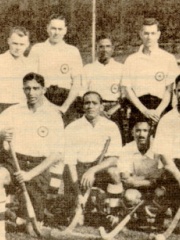
10. Richard Allen (1902 - 1969)
With an HPI of 49.60, Richard Allen is the 10th most famous Indian Athlete. His biography has been translated into 22 different languages.
Richard James Allen (4 June 1902 – 1969) was an Indian field hockey player who competed in the Summer Olympics in 1928, 1932, and 1936. He was born in Nagpur, India, and did his schooling at the prestigious Oak Grove School, Mussoorie and later at St. Joseph's College, Nainital. In the 1928 Summer Olympics, he played five matches as goalkeeper, and no goals were scored against him. Four years later, he played one match against the United States as goalkeeper. The American team scored one goal against him, while he was off the field signing autographs (the final score was 24–1 in India's favour, a world record at that time). In the 1936 Summer Olympics he played four matches as goalkeeper. One goal was scored against him. This tally of conceding only two goals over three Olympic Games remains an Olympic record to this day.
People
Pantheon has 135 people classified as Indian athletes born between 1872 and 2003. Of these 135, 124 (91.85%) of them are still alive today. The most famous living Indian athletes include P. T. Usha, Deepika Kumari, and Bombayla Devi Laishram. The most famous deceased Indian athletes include Godfrey Brown, Balbir Singh Sr., and Charles Gmelin. As of April 2024, 24 new Indian athletes have been added to Pantheon including Anjali Bhagwat, Shiny Abraham, and Bobby Aloysius.
Living Indian Athletes
Go to all RankingsP. T. Usha
1964 - Present
HPI: 53.09
Deepika Kumari
1994 - Present
HPI: 49.02
Bombayla Devi Laishram
1985 - Present
HPI: 47.97
Laxmirani Majhi
1989 - Present
HPI: 45.63
Karnam Malleswari
1975 - Present
HPI: 45.19
Seema Punia
1983 - Present
HPI: 44.29
Abhinav Bindra
1982 - Present
HPI: 43.01
Kunjarani Devi
1968 - Present
HPI: 42.77
Deepa Malik
1970 - Present
HPI: 41.81
Neeraj Chopra
1997 - Present
HPI: 41.39
Anju Bobby George
1977 - Present
HPI: 40.77
Anjali Bhagwat
1969 - Present
HPI: 39.42
Deceased Indian Athletes
Go to all RankingsGodfrey Brown
1915 - 1995
HPI: 63.84
Balbir Singh Sr.
1923 - 2020
HPI: 59.11
Charles Gmelin
1872 - 1950
HPI: 59.04
Launceston Elliot
1874 - 1930
HPI: 58.83
K. D. Jadhav
1926 - 1984
HPI: 55.98
Fauja Singh
1911 - 2025
HPI: 55.91
Leslie Claudius
1927 - 2012
HPI: 50.26
Udham Singh
1928 - 2000
HPI: 50.06
Richard Allen
1902 - 1969
HPI: 49.60
Ajit Pal Singh
1947 - Present
HPI: 48.40
Mohammed Shahid
1960 - 2016
HPI: 43.18
Newly Added Indian Athletes (2025)
Go to all RankingsAnjali Bhagwat
1969 - Present
HPI: 39.42
Shiny Abraham
1965 - Present
HPI: 38.06
Bobby Aloysius
1974 - Present
HPI: 35.97
Jyotirmoyee Sikdar
1969 - Present
HPI: 35.60
Kavita Tungar
1985 - Present
HPI: 34.45
K. M. Beenamol
1975 - Present
HPI: 33.73
Devendra Jhajharia
1981 - Present
HPI: 31.65
Sandeep Kumar
1986 - Present
HPI: 30.24
Shiva Keshavan
1981 - Present
HPI: 29.74
Avani Lekhara
2001 - Present
HPI: 29.50
Khushbir Kaur
1993 - Present
HPI: 29.35
Ashwini Akkunji
1987 - Present
HPI: 29.34
Overlapping Lives
Which Athletes were alive at the same time? This visualization shows the lifespans of the 10 most globally memorable Athletes since 1700.


